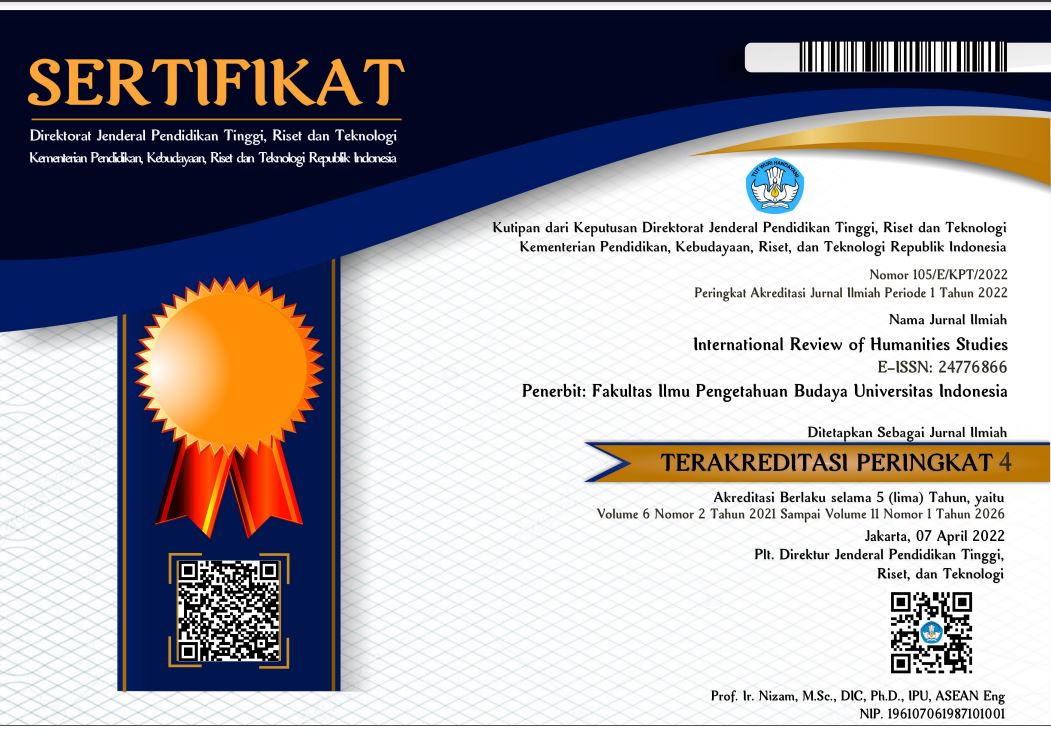International Review of Humanities Studies

Abstract
This paper investigated the propaganda strategies in kamishibai (a paper play) story telling in Djawa Baroe Magazine. This study employed text analysis methods and propaganda theories from Jowett and Donnell on the seven kamishibai and found the following propaganda strategies. First, Western powers were portrayed negatively. Second, Japan was not explicitly featured in kamishibai stories. Third, local cultural elements in Javanese culture were used to convey propaganda messages. These findings indicate that entertainment media, such as kamishibai, can be used as propaganda media and subtly inserted using specific trivial strategies.
References
Irianti, M.B. (2014). Menabur kebiasaan: propaganda gerakan menabung Jepang 1942- 1945. Lembaran Sejarah 11 (1), 71-82.
Iwaya, S. (1984). “Momotaro Shugi Kyooiku” no Hanashi : Iwaya Sazanami Botsugo 50-Nen Kinen no Shuppan. Tokyo: Hakubunkan Shinsha.
Jowett, G and O’Donnell, V. (2006). Propaganda and Persuasion. California: Sage Publications.
Kurasawa, A. (1987). Propaganda media on Java under the Japanese 1942-1945. Indonesia, 44, 59-116.
Kurasawa, A. (1992). Jawa Baru: Shin Jawa Vol 3 & 4. Tokyo: Ryuukei.
Kurasawa, A. (2015). Kuasa Jepang di Jawa: Perubahan Sosial di Pedesaan 1942-1945. Depok: Komunitas Bambu.
Kutzer, D.M. (2002). Empire’s Children: Empire and Imperialism in Classic British Children. New York: Routledge.
Momose, Y. (2002). Kamishibai as a military propaganda tool: a case study of Indonesia 296 under Japanese occupation (1942-45). Southeast Asia: History and Culture 31, 97-112.
https://doi.org/10.5512/sea.2002.97.
Orbaugh, S. (2013). The properly feminine nationalist body in the propaganda "kamishibai" of Suzuki Noriko. US-Japan’s Women Journal 45, 50-68.
Orbaugh, S. (2015). Propaganda Performed: Kamishibai in Japan Fifteen Year War. Leiden: Brill.
Orbaugh, S. (2018). Play, education, or indoctrination? kamishibai in 1930s Japan. Mechademia: Second Arc 11 (1), Childhood (Fall 2018), 65-91
Said, E. W. (1994). Culture and Imperialism. New York: Vintage Books
Shimizu, H. (1987). Nanshin-ron: its turning point in world war I. The Developing Economies, XXV (4), 386-402.
Tierney, R. T. (2010). Tropics of Savagery: The Culture of Japanese Empire in Comparative Frame. Berkeley: University of California Press.
Widjanarko, P. (2020). Messages from the ‘older brother’: Djawa Baroe magazine and the Japanese propaganda in Indonesia in 1943-1945. Jurnal Komunikasi Ikatan Sarjana Komunikasi Indonesia 5(1), 63-74.
Recommended Citation
Pasaribu, Rouli Esther
(2024)
"ABSENT BUT PRESENT: PROPAGANDA STRATEGIES OF THE JAPANESE OCCUPATION IN INDONESIA AS NARRATED IN KAMISHIBAI IN DJAWA BAROE MAGAZINE,"
International Review of Humanities Studies: Vol. 9:
No.
1, Article 22.
DOI: 10.7454/irhs.v9i1.1289
Available at:
https://scholarhub.ui.ac.id/irhs/vol9/iss1/22
Included in
Anthropology Commons, Art and Design Commons, Creative Writing Commons, Cultural Heritage Law Commons, Education Law Commons, Film and Media Studies Commons, History Commons, Intellectual Property Law Commons, International and Area Studies Commons, Legal Writing and Research Commons, Linguistics Commons, Museum Studies Commons, Philosophy Commons, Urban Studies and Planning Commons


